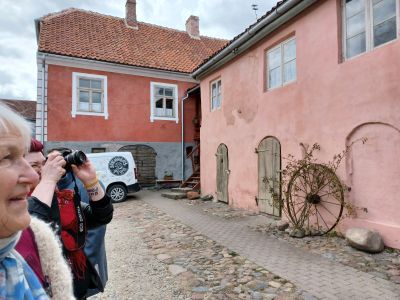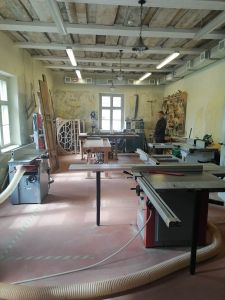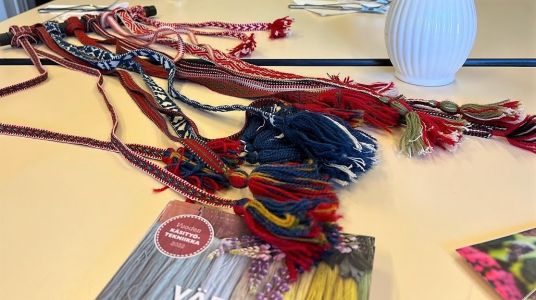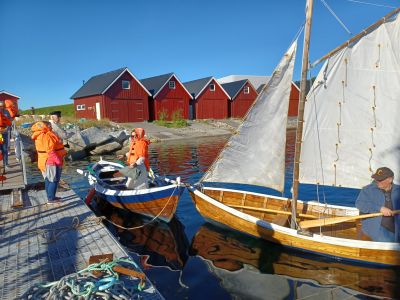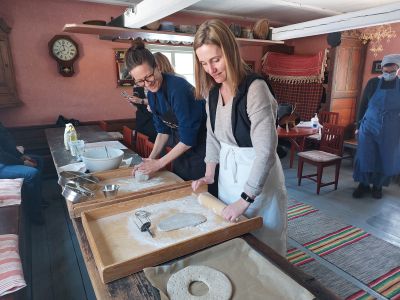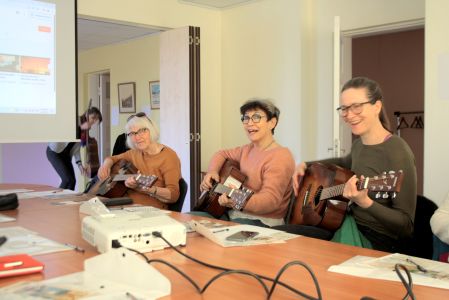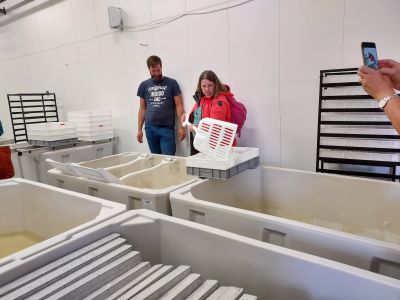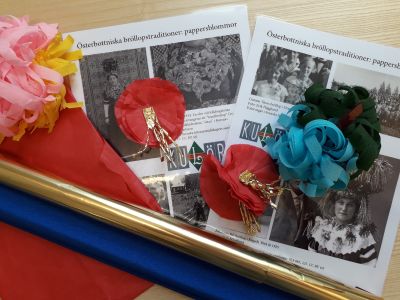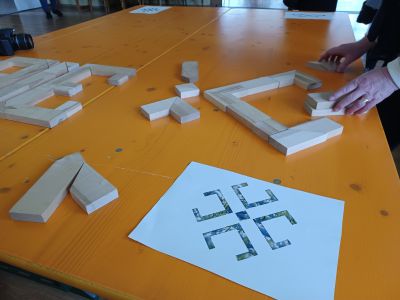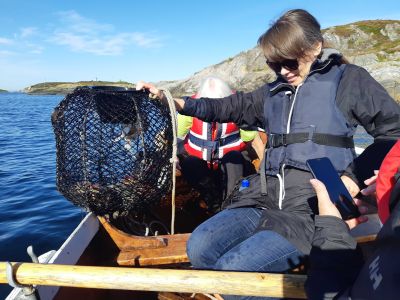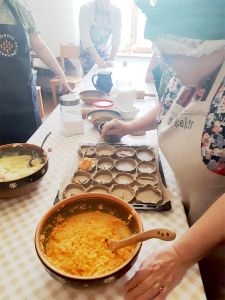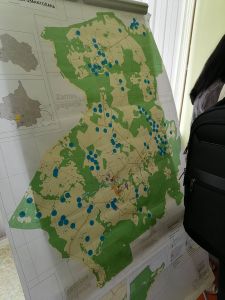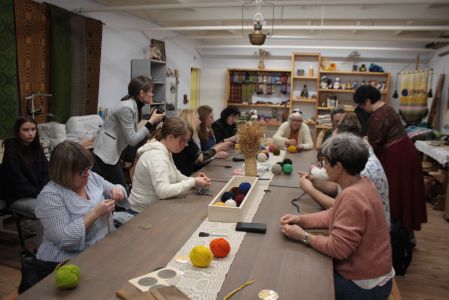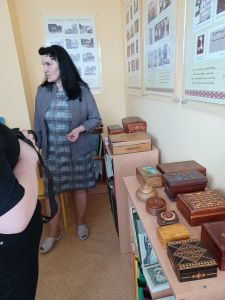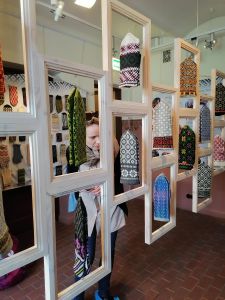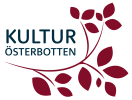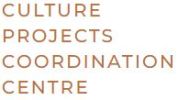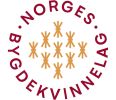Documentations
Here you will find documentation from our study visits, focusing on intangible cultural heritage and methods for transmitting traditional knowledge. We have collected inspirational photos and uploaded short videos from the study visits.
A section on the materials created as preparations for the study visits is also included, as well as a map to illustrate the study visits.
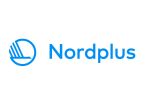
SAFEGUARDING OF INTANGIBLE CULTURAL HERITAGE THROUGH LEARNING.
NPAD-2020/10090
Inspirational Photos
-
Visiting like-minded
![]()
The heart and soul of our project was to meet, experience and learn from eachother. The participants of the study visits were instructed to document their impressions and pay attention to how transmission of traditional culture can be achieved. We have learned so much and gained so many influences and good ideas!
-
Experiencing the livelihood
![]()
At Bjørnsund, Norway, we experienced the traditional livelihood of the islanders through fishing - including rowing to our gear with traditional boats. We caught cod and crabs, that we later cooked and tasted.
-
Support and encourage
![]()
During our visit with project partner Culture projects coordination centre in Kuldīga, Latvia, we were introduced their impressive wood shop for restauration works. Situated in the old town, they offer expertice and a work place for inhabitants that wish to work on restoring their traditional houses.
-
Work for your pleasures
![]()
We were instructed in how to bake traditional flat bread on Gossen, Norway. Baking, preparing, eating with coffee - such a nice afternoon!
-
Even the small details...
![]()
We crafted tassled and investigated their traditional use as a pop up workshop. Here: traditional ribbons woven by Anna Nordström, Ostrobothnia Finland.
-
Try out handicraft
![]()
Workshop for decorating ceramics in Kuldīga Latvia, lead by Kristīne Šimpermane. We painted butterflies, prepared by Kristine, and were surprised by the professional outcome!
-
The cultural heritage game
![]()
At the Culture Projects Coordination Center in Kuldīga, Latvia, we were introduced to the cultural heritage game - working in groups we chose four heritage element to bring along on an arc as the only salvages of earthly culture. Very interesting exchange of thoughts!
-
Introduction to coastal traditions
![]()
Together with Rømsdal Kystelag we were introduced to traditional boating. This group of enthusiasts introduce local shools to rowing in the same manner, a lovely experience!
-
Baking as part of guiding
![]()
At Stundars open air museum, Ostrobothnia Finland, we participated in a workshop on traditional food while being introduced to the museum area. The staff demonstrated the different tasks, and then we were put to work!
-
Learning through the Internet
![]()
The Internet provides plenty of material that can be helpful when it comes to safeguarding ICH. In Jaunpils, Latvia, we tried out learning basic music skills through the Internet. These skills are needed in order to start practicing traditional music.
-
Visiting the factory
![]()
During our visit at Gossen, Norway, we got to see a sea salt factory from the inside. For those of us who come from areas with brackish water, this was a new experience, and a very good introduction to how the local communities for generations have used the salty sea to manufacture the salt they need for daily use.
-
Crafting traditional objects
![]()
During the visit in Ostrobothnia, Finland, we experienced a popup workshop during an evening together. The concept of a short activity, with drop in participation, can be applied to many different activities. We tried making traditional paper flowers and tassles.
-
Using archive material
![]()
Many archives are filled with materials in connection to ICH. In Ostrobothnia, Finland, we were acquainted with how historical photos can be used to spark interest and start discussions about living traditions. The topic of our case study: traditional paper flowers, that have been used as decorations at weddings.
-
Traditional symbols as puzzles
![]()
During our visit in Latvia, we encountered these very smart puzzles. Graphic traditional symbols have been printed out on A4 paper, and the task of the participants are to recreate them using wood blocks. A very good way to entertain visitors, and at the same time interest them in aspects of traditional culture.
-
Participatory observation
![]()
On an increadibly beautiful day, we were acquainted with traditional crab fishing at Bjørnsund, Norway. This was very much a participatory observation, as we were sent out in traditional rowing boats with the task of retreiving certain crab tins. A lovely experience!
-
Hands-on cuisine
![]()
In Suiti Cultural Center we were introduced to Suiti cuisine through hands on baking. We made sklandrausis from scratch and experienced new aspects of the local traditions.
-
From sea to table
![]()
After trying out crab fishing, we got to learn how to handle and prepare crab by the experts at Bjørnsund leierskole, Norway. As we come from parts of the Nordic/Baltic region with very different geography, this was something completely unknown to many of us. The camp school ("leirskole") is a great inspiration both for how to transfer ICH to children and when it comes to how ICH could be used for integration.
-
Mapping what has been lost
![]()
In Viesats, Latvia, we were introduced to a project for mapping lost houses in the parish. Through exhibitions and research, information about the lost houses and the people who once lived there is collected. This is such a meaningful project to bring light to societal changes and historical processes.
-
The next best thing
![]()
At Craft House Jaunpils, Latvia, we were introduced to weaving with paper looms. We created ribbons using wool yarn. The craft house has a big department filled with traditional looms, but for visitors this is a much better activity for those who want to try some handicraft in practice. Meanwhile, we could enjoy a presentation of the wool projects run by the Craft House.
-
Safeguarding on the local level
![]()
In Viesats, Latvia, we experienced how safeguarding can be done on the local level. By creating multiple theme rooms, local volonteers make sure that local ICH is visible and available to the interested.
-
Choosing how to display
![]()
During our study visits, we have encountered multiple ways of displaying ICH. Here, at the regional museum om Kuldīga, Latvia, creative means of showcasing models and connecting them to the processes in which they are crafted had been used.
Filmed documentations
Materials from the Study Visits
-
Guide: Documentation
This guide for how to document living traditions was developed during the project.
-
Questionnaire: Visits
This is the quiestionnaire developed within the project that we have used to evaluate the experiences of our participants. This is a pdf-version of our online questionnarie.
-
Program: Finland
Program for Study Visit in Ostrobothnia week 13 2022.
-
Program: Latvia
Program for Study Visit in Jaunpils and Kuldīga week 17 2022.
-
Program: Norway
Program for Study Visit in Molde week 35 2022.
-
Final report
The final report for Safeguarding of Intangible Cultural Heritage through Learning.
The Study Visits
The backbone of our project has been visiting eachother in order to learn and find inspiration.
Ostrobothnia, Finland (KulturÖsterbotten)
Jaunpils, Latvia (Regional Development Center Wheel)
Kuldīga, Latvia (Culture Projects Coordination Centre)
Molde, Norway (Norwegian Society of Rural Women)
Molde
Our study visit in Norway will be carried out in the Molde region.
Jaunpils, Latvia
Our visit in Latvia was partly spent in Jaunpils parish. Lokal hosts: Rats.
Ostrobothnia, Finland
Ostrobothnia, Finland
Our study visit in Finland focused on the area around Vaasa.
Kuldīga
Our study visit in Latvia was partly spent in Kuldīga.
